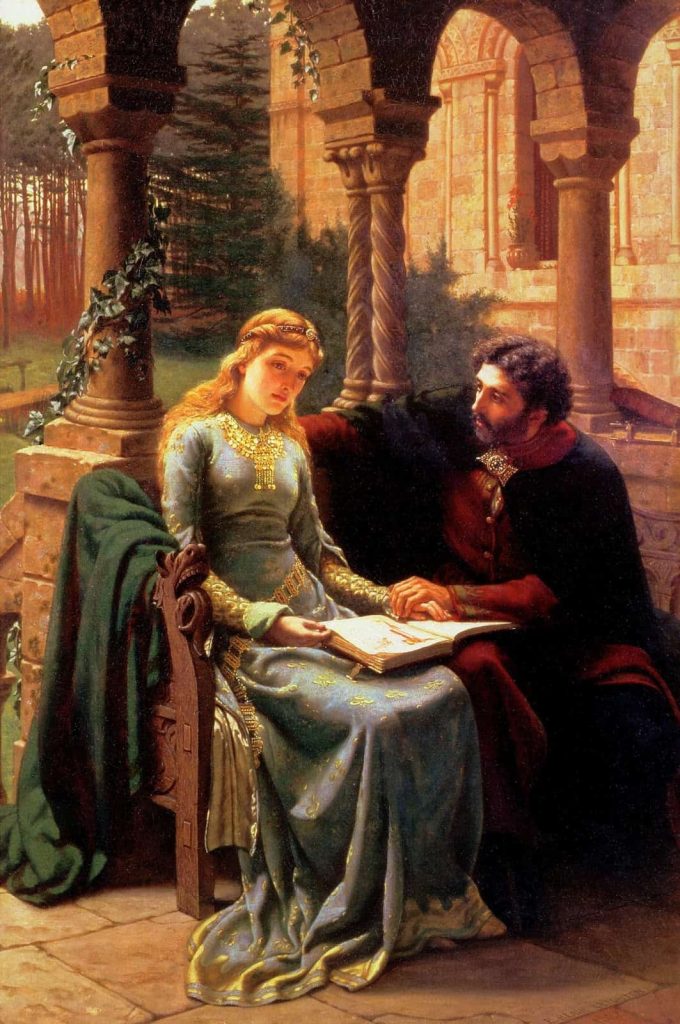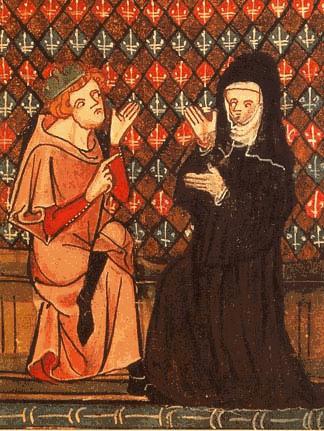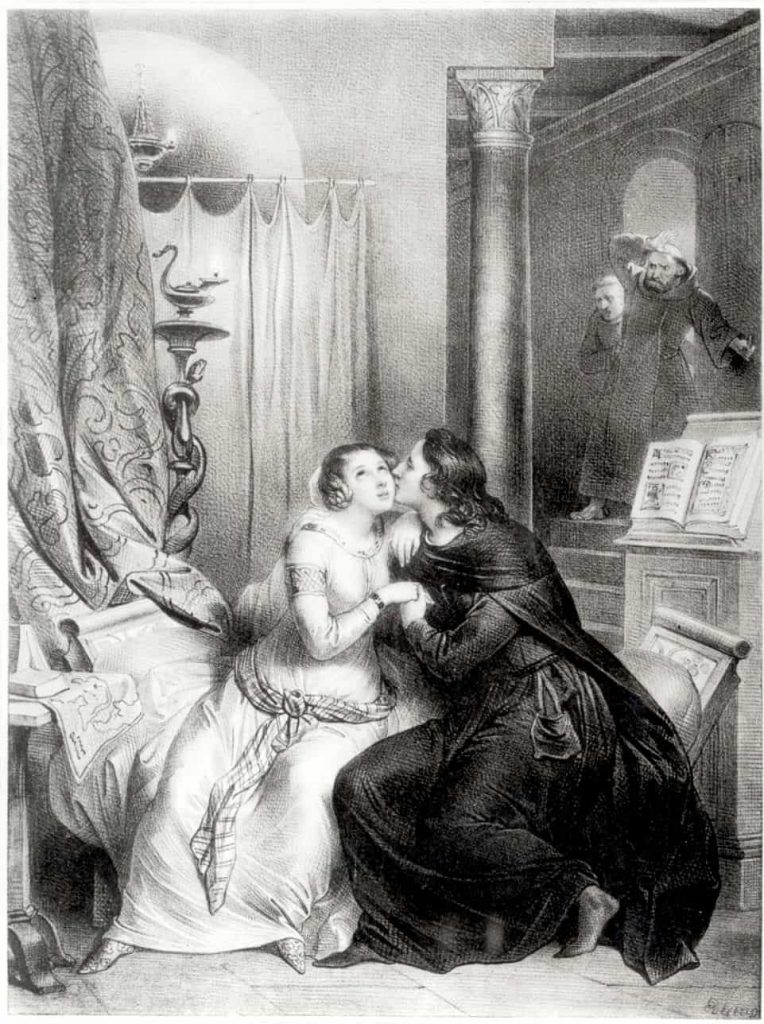Everyone knows the names Romeo and Juliet. The story of star-crossed lovers from rival families is known throughout the world for its timeless tale of romance. This has always struck me as a little bit odd considering that the story of Romeo and Juliet is one of a three day romance between two teenagers that results in the deaths of six people. Tragic? Certainly. Romantic? I suppose that would depend on your definition of romance. But the epitome of eternal love? I think not. For myself, that mantle will always be held by a pair of lovers whose story is infinitely more romantic, more loving, and more tragic than anything to be found in fair Verona. And unlike Shakespeare’s tale, the story of Heloise and Abelard is true.

To tell this tale, we have to journey back to the Paris of the 12th century, a time when the city was flourishing after centuries of attacks and invasions. In 1100, a young man arrived in Paris to study at the school of Notre-Dame. His name was Pierre Abelard, and he was a member of a noble family in Brittany. Abelard could have led a life of luxurious existence, but instead, he gave up his inheritance to pursue his studies. Once in Paris, he quickly made a name for himself as a brilliant scholar.
Unfortunately for Abelard, he also gained quite the reputation for his radical educational philosophies. He dared to challenge his teachers, and he was prone to provoking discussions and debates during his classes. Most egregiously, he had the audacity to question the teachings of his professors. At that time, to challenge the word of the church was nothing short of blasphemy, and he was quickly kicked out of school. For the next 15 years, Abelard travelled throughout France, all the while studying, teaching, and founding his own schools throughout the country. Over time, he became known as one of the foremost scholars and thinkers of his generation.
In 1115, Abelard moved back to Paris to become Master of the Notre-Dame school. He was 36 years old, at the height of his success and confidence, and he was quite arrogant about it. He later wrote in his autobiography that he “had youth and exceptional good looks as well as my great reputation to recommend me, and feared no rebuff from any woman I might choose to honour with my love.” However, unknown to him, Abelard was about to meet his match.
At the time of Abelard’s return to Paris, a woman by the name of Heloise was living next to the school of Notre-Dame under the guardianship of her uncle, Canon Fulbert. Fulbert had spared no expense in her education, and by the time she was in her early 20s, Heloise was fluent in multiple languages, she was a renowned theologian and writer, she was extraordinarily widely read, and she was an all around brilliant scholar. Even back then, Heloise was described as being Abelard’s intellectual equal in every way. Naturally, these two were quickly drawn together.

In order to facilitate more time in each other’s company, Abelard became a lodger in Fulbert’s home under the guise of tutoring Heloise in philosophy. However, philosophy was quickly abandoned in favour of a passionate love affair. Abelard wrote that their nights were “sleepless with lovemaking”, and that their “desires left no stage of lovemaking untried.” Yes, that is an actual sentence that was written in the 12th century by an unmarried man of the church who was sleeping with the beloved niece of a powerful clergyman. Unsurprisingly, their love affair was not to last.
Also unsurprisingly when your nights are sleepless with lovemaking, Heloise soon became pregnant. For her protection, Abelard sent her to Brittany to have their baby under the care of his family, and their son, Astrolabe, was born in 1116. This unfortunately named little boy was immediately sent to live with Abelard’s sister, and he was never heard from again. His parents, however, were not quite so lucky.
After giving birth, Heloise returned to Paris to resume her relationship with Abelard, but there was one rather important person who was opposed to this idea. Canon Fulbert had discovered their illicit relationship prior to Heloise becoming pregnant, and he had ordered the lovers to end their affair. When Abelard sent Heloise away to Brittany to give birth, he wrote that “her uncle went out of his mind” in rage and grief. Needless to say, Fulbert was not pleased to discover that his beloved niece was now back with the man who had sullied her honour.

In order to placate Fulbert, Abelard proposed marriage to Heloise, but she was dead set against the idea. She later wrote that she “preferred love to wedlock. Freedom to a bond.” In her mind, marriage was a transaction akin to prostitution, and therefore not deserving of her love. She wrote to Abelard that “the name of wife may seem more sacred or more binding, but sweeter for me will always be the word mistress.” Nevertheless, Abelard persisted, and they were married in Paris in 1116. Heloise later noted that in their union, “we shall both be destroyed. All that is left to us is suffering as great as our love has been.” Ominous words to be sure, but entirely prophetic.
At Heloise’s insistence, the marriage was to be kept a secret so as not to damage Abelard’s career. Although Fulbert initially agreed to this stipulation, he soon went back on his word. He publicly revealed their marriage, and to put it mildly, all hell broke lose. Abelard’s reputation was ruined overnight, and the court of public opinion turned against the couple. Fearing an attack on their lives, Abelard sent Heloise away from Paris for her own safety, but he failed to mention his reasons for doing so to her uncle. Fulbert, for his part, saw this act as Abelard trying to conveniently get rid of Heloise. This was one disgrace too many, and Fulbert began plotting his revenge.
Late one night while Abelard was sleeping, several men, under the orders of Fulbert, broke into Abelard’s room and violently castrated him. At the time, castration was considered to be a serious offence, and so perhaps Abelard later took comfort in the knowledge that both Fulbert and his hired hands were swiftly and brutally punished for their crimes. Nevertheless, this was the event that ultimately put an end to Heloise and Abelard’s relationship. Abelard became a monk, and at his insistence, Heloise became a nun. They were never together as man and wife again.
While this may sound like the end of their story, Heloise and Abelard managed to continue on in the form of letters that they sent to each other throughout their lives. Although they had been driven apart, their love endured for decades after their forced parting. Today, their correspondence provides some of the most historically fascinating insights into love, sexuality, and relationships in 12th century France.
“I beg you then listen to what I ask – you will see that it is a small favour that you can easily grant. While I am denied your presence, give me at least through your words some sweet semblance of yourself.” – Heloise
“If since our conversion from the world to God I have not yet written you any comfort or advice it must not be attributed to indifference on my part but to your own good sense, in which I have always had such confidence that I did not think anything was needed.” – Abelard
The words of Heloise in particular have sparked much discussion and debate among historians and scholars. Her frankness and blunt views on marriage, love, and sex would have likely seen her burnt at the stake for heresy had she been born several centuries later. Her words offer a glimpse into the sexual politics of 12th century Paris, and today, Heloise is considered to be one of the foremost feminist voices of her time.
“What man, bent on sacred or philosophical thoughts, could endure the crying of children? And what woman will be able to bear the constant filth and squalor of babies?” -Heloise
“While we enjoyed the pleasure of an uneasy love and abandoned ourselves to fornication (if I may use an ugly but expressive word) we were spared God’s severity. But when we amended our unlawful conduct by what was lawful, and atoned for the shame of fornication by an honourable marriage, then the Lord in his anger laid his hand heavily upon us and would not permit a chaste union when he had long tolerated an unchaste one.” – Heloise
“I am judged religious in a time when there is little in religion that is not hypocrisy.” – Heloise
Pierre Abelard died in 1142, and Heloise followed in 1168. They were interred together in the Oratory of the Paraclete, a monastery that Abelard had founded and where Heloise spent the later half of her life. Their remains would later be moved no less than five times, ultimately finding their current home in the Père-LaChaise cemetery in Paris in 1817. Josephine, the first wife of Napoleon Bonaparte, was so moved by their story that she wanted to ensure that their love would endure forever. Today, lovers from all over the world still leave love letters at the tomb of Heloise and Abelard.
It has been over 900 years since Heloise and Abelard first fell in love, but their story still lives on. Theirs was not a fairytale romance. It was messy and complicated, filled with scandal and violence. Their love was passionate and enduring, but it was also flawed and conflicted, and sadly, their time spent in each other’s company was ultimately very short. However, despite everything that they endured, they remained devoted to each other until the very end. Perhaps that is why we still talk about their love to this day. It was real. It was palpable. And it will stand the test of time.
“Now that our love has grown so strong that it shines forth by itself there is little need of words because we are overflowing with what is real.”
– Abelard
“Since it is established that this is eternal, it is for me the proof beyond doubt that you will remain in my love for eternity.” – Heloise
_______________________________________________________________
Laura Moore is a professional storyteller who loves history and the many stories that make Paris one of the most fascinating cities in the world. Join one of her signature tours to learn the story of a city.



